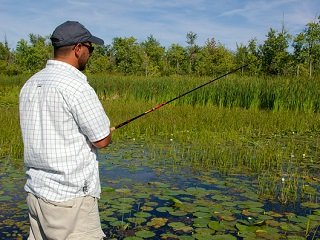 Some anglers count themselves as seasoned vets, especially when it comes to specific techniques used to haul in monster fish. However, not everyone is at that level, and it pays to receive a lesson in the basics. Furthermore, perfection is a matter of perception, and we can all use a refresher course, no matter how long we’ve been doing something. Who knows? It might teach you something new. That being said, here are a few tips to help fine tune your flipping.
Some anglers count themselves as seasoned vets, especially when it comes to specific techniques used to haul in monster fish. However, not everyone is at that level, and it pays to receive a lesson in the basics. Furthermore, perfection is a matter of perception, and we can all use a refresher course, no matter how long we’ve been doing something. Who knows? It might teach you something new. That being said, here are a few tips to help fine tune your flipping.
One thing that many anglers overlook is the tackle they use for flipping. You’ll want to be sure to use a rod designed for the technique. Long, strong fishing rods are ideal for this because their length allows you to flip further and their power will muscle fish from thick cover with ease. Also, the reel you use will be important, and a fast one is a good idea. While you won’t be working with long casting distances, you will need to be able to take in line quickly. Fish tend to run for deeper water when they’re hooked, which typically means right under your boat when you’re flipping. You’ll need to take up the slack line as fast as possible and use the power of the rod to keep the fish from running under the boat.
Continuing with proper tackle, the line you use will have an effect on your flipping effectiveness, as well. Braid tends to be the obvious choice, if not the most popular, for most conditions, but it’s not always the best choice. For instance, when flipping around timber or fallen trees, braid is so tough that it can actually get stuck in the wood. In such cases, it’s actually better to go with heavy fluorocarbon. Fluorocarbon is ideal in clear water, as well, but for everything else, I’d go with braid. You just can’t beat the way braid slices through lily pads and weeds like a hot knife through butter.
When flipping, it pays to pay attention to the depth at which you’re getting strikes. Often times, bass will find a comfortable depth and stay there, even in cover. Once you find that depth, you can find more areas with similar water depth and fish it with great results. Lastly, pay attention to the cover. Fish tend to stick close to areas where there’s a variety of cover and vegetation present, so look for such places.
Whether you’re new to the flipping game, or you’re an old salt, information never hurts. Hopefully the tips outlined above help the next time you’re on the water, no matter which category you fall in.








